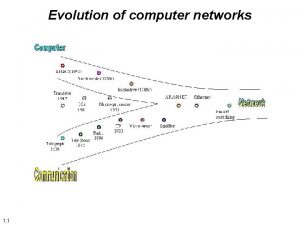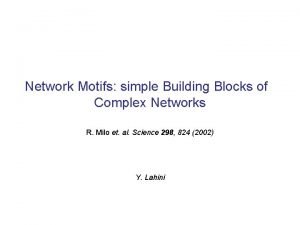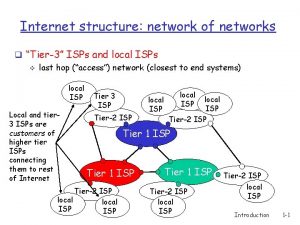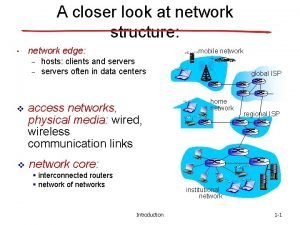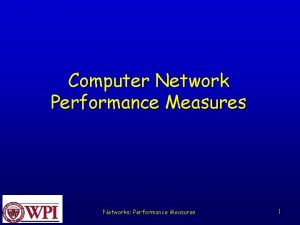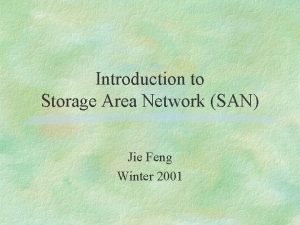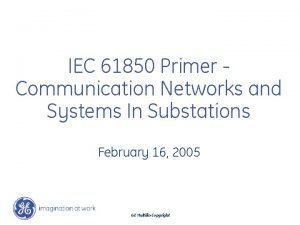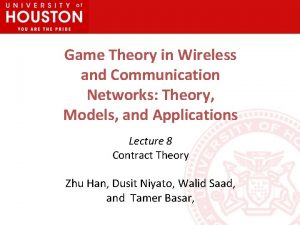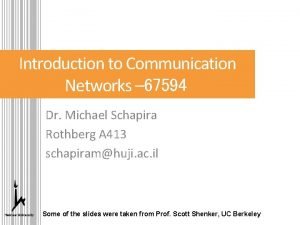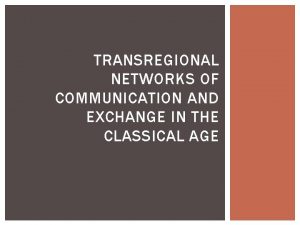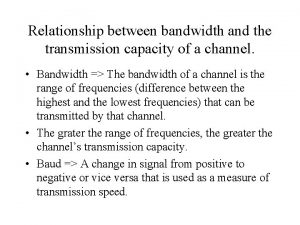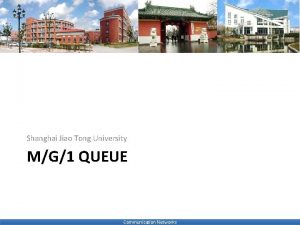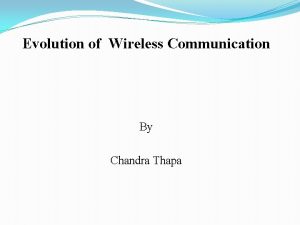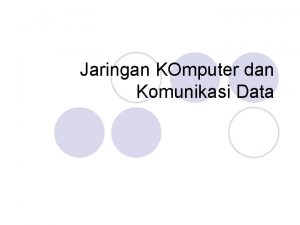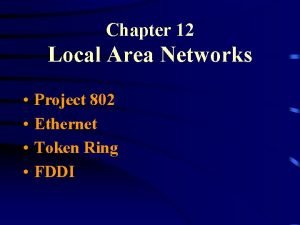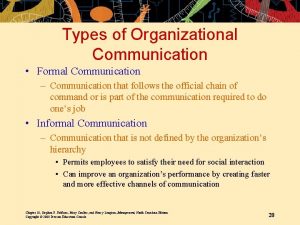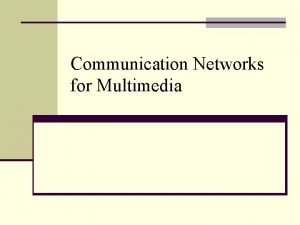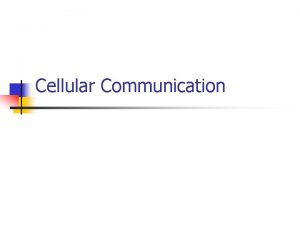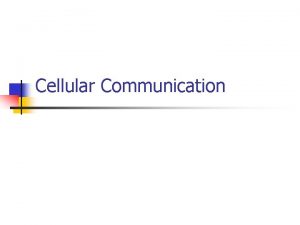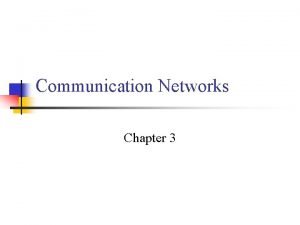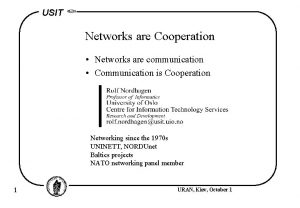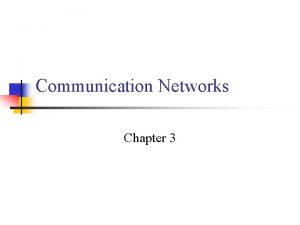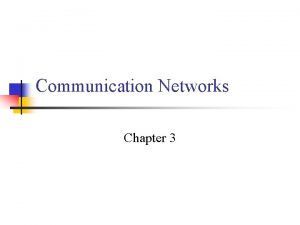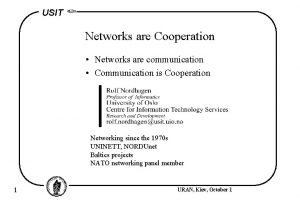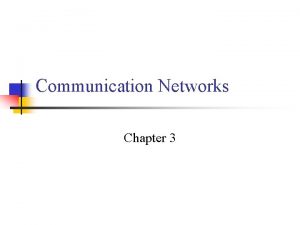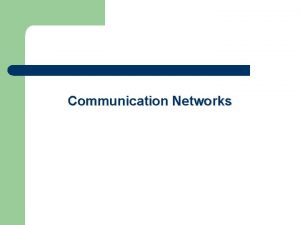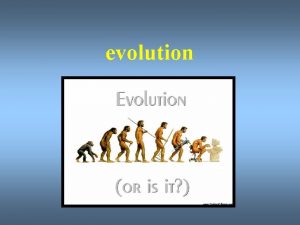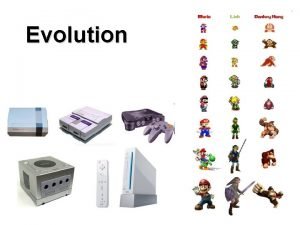COMMUNICATION NETWORK EVOLUTION OF COMMUNICATION NETWORKS Communication is
































- Slides: 32

COMMUNICATION NETWORK

EVOLUTION OF COMMUNICATION NETWORKS

Communication is derived from a Latin word – COMMUNICARE which means “TO SHARE”. It is a purposeful activity that helps exchanging information and meaning across space and time using various technical or natural means, whichever is preferred. The communication process is complete once the receiver understands the sender's message.

Types of Communication �Communication involves the imparting or interchanging thoughts, opinions, or information among people by speech, writing, or signs. People communicate in different ways. Verbal Written Oral Non Verbal Para language Visual Physical Nonverbal

�Verbal communication : Entails the use of words in delivering the intended message. The two major forms of verbal communication include written and oral communication. v Written communication includes traditional pen and paper letters and documents, typed electronic documents, e mails, text chats, SMS and anything else conveyed through written symbols such as language. This type of communication is indispensable formal business communications and issuing legal instructions. Communication forms that predominantly use written communication include handbooks, brochures, contracts, memos, press releases, formal business proposals, and the like. The effectiveness of written communication depends

v Oral Communication word, either face to face or through phone, voice chat, video conferencing or any other medium. Various forms of informal communications such as the grapevine or informal rumor mill, and formal communications such as lectures, conferences are forms of oral communication. Oral communication finds use in discussions and causal and informal conversations. The effectiveness of oral conversations depends on the clarity of speech, voice modulation, pitch, volume, speed, and even non verbal communications such as body language and visual cues. Verbal communication makes the process of conveying thoughts easier and faster, and it remains the most

�Nonverbal Communication Nonverbal communication entails communicating by sending and receiving wordless messages. These messages usually reinforce verbal communication, but they can also convey thoughts and feelings on their own. v Physical nonverbal communication, or body language, includes facial expressions, eye contact, body posture, gestures such as a wave, pointed finger and the like, overall body movements, tone of voice, touch, and others. Facial expressions are the most common among all nonverbal communication. For instance, a smile or a frown conveys distinct emotions hard to express through verbal communication.

v Para-language The way something is said, rather than what is actually said, is an important component of nonverbal communication. This includes voice quality, intonation, pitch, stress, emotion, tone, and style of speaking, and communicates approval, interest or the lack of it. Research estimates that tone of the voice accounts for 38 percent of all communications. Other forms of nonverbal communication usually communicate one’s personality. These include: a) Aesthetic communication or creative expressions such as dancing, painting, and the like. b) Appearance or the style of dressing and grooming, which communicates one’s personality. c) Space language such as paintings and landscapes communicate social status and taste. d) Symbols such as religious, status, or ego building

� Visual Communication A third type of communication is visual communication through visual aids such as signs, typography, drawing, graphic design, illustration, color and other electronic resources. Visual communication with graphs and charts usually reinforces written communication, and can in many case replace written communication altogether. As the adage goes “a picture is worth a thousand words”; such visual communication is more powerful than verbal and nonverbal communication on many occasions. Technological developments have made expressing visual communications much easier than before. A good understanding of the different types of communication and communication styles can help you know and deal with people better, clear up misunderstandings and misconceptions, and contribute to the success of the enterprise. (Typography is the art and technique of arranging type to make written language readable and beautiful. The arrangement of type involves

Networking � Interact with others to exchange information and develop professional or social contacts. � There is a fine line between Communication and Networking. � Communication involves exchanging of messages in various forms like face to face interaction or even with the help of technology. � However, Network refers to exchange of messages only with the help of use technology like the computers or other modes of communication like phones etc…

Providers and Consumers An end point that produces information is known as a "producer" or a "server". An endpoint that receives information is known as a "consumer" or a "client". In many networks, such as bi directional networks, an endpoint can be both a client and a server. Bi-directional Communications Bi directional communications means that data is flowing both to and from an end point. An end point can be both a client and a server. Point-to-point communication Some channels are point to point they have only a single producer (at one end), and a single consumer (at the far end). Many networks have "full duplex" communication between nodes, meaning they have 2 separate point to point channels (one in each direction) between the nodes (on separate wires or allocated to separate frequencies). Some "mesh" networks are built from point to point channels. Since wiring every node to every other node is prohibitively expensive, when one node needs to communicate with a distant node, the

Multiple Access Multiple access networks are networks where multiple clients, multiple servers, or both are attempting to access the network simultaneously. Networks with one server and multiple clients are called "broadcast networks", "multicast networks", or "SIMO networks". "SIMO" stands for "Single Input Multiple Output". Networks with multiple clients and servers are known as "MIMO" or "Multiple Input Multiple Output" networks. Data Collisions In a MIMO network, when multiple servers attempt to send data on a single channel at the same time, a data collision occurs. Because data typically consists of electric or electromagnetic radiation, a data collision causes both pieces of information to become unreadable. Clients on the network will either read meaningless data (garbage data) or will read no data at all. MIMO networks therefore will use some sort of

COMMUNICATION NETORK � Defined by their size and complexity, they come in four main types: v (1) small networks, used for the connection of subassemblies and usually contained in a single piece of equipment; v (2) Local Area Networks, or LAN, cables or fibers used to connect computer equipment and other terminals distributed in a localized area, such as on a college campus; v (3) Metropolitan Area Networks, or MAN, a high speed network used to interconnect LANs spread around a small geographic region such as a city; v (4) Wide Area Networks, or WAN, multiple communication connections, including microwave radio links and satellites, used to connect computers and other terminals over large

TYPES OF COMMUNICATION NETORK

LOCAL AREA NETWORK Local Area Network (LAN) is a collection of networking equipment located geographically close together. It can be in a single room or the same campus etc… There is low implementation cost involved. Data can be transferred from 1 km to 10 kms. It has been designed to share resources between PCs and the work station like hardware or data. User requires LAN to access the internet.

� MERITS v Cost reductions through sharing of information and databases, resources and network services. v Increased information exchange between different departments in an organization or individuals. v Trend to automate communication and manufacturing process. � DEMERITS v Special security measures needed to stop users from using programs and data they must not access. v Networks are difficult to set up and need to be maintained by skilled technicians. v All users are affected if the file server develops a serious fault.

Metropolitan Area Network is also known as MAN. It is designed to extend network over an entire city. It may be a single network like the cable television network available in many cities. It’s range is within 100 kms.

�MERTIS v Provides backbone for large network and greater access to WANs. v Transmission of data is done in both directions simultaneously. It’s a to way process. v Usually encompasses several blocks of a city or an entire city �DEMERITS v More cables required for connection from one place to another. v Difficult to secure the system from hackers and

WIDE AREA NETORK �It is also known as WAN. It is a form of network that provides long distance transmission of data, voice, image and video information over large geographical areas that may comprise a country or a continent. It has a range of 100 kms and more.

� MERITS v Covers large geographical area v Shares software and resources with connecting workstations. v Effective working mechanism. Can have pictures, sounds etc. v Expensive things like printers etc can be shared in a network and all in the network can use the same data. � DEMERITS v Need a good firewall to restrict outsiders from entering and disrupting the network. v Can be expensive, slow and complicated to set up a network. v Requires network supervisors and technicians to maintain the network throughout. v Security problems when different people use information from other computers. Protection against hackers, viruses etc makes it more complex and expensive.

Difference between LAN, MAN and WAN

Wireless Network � A wireless network is any type of computer network that uses wireless data connections for connecting network nodes. � Wireless networking is a method by which homes, telecommunications networks and enterprise (business) installations avoid the costly process of introducing cables into a building, or as a connection between various equipment locations. Wireless telecommunications networks are generally implemented and administered using radio communication. This implementation takes place at the physical level (layer) of the OSI model network structure. � Examples of wireless networks include cell phone networks, Wi. Fi local networks and terrestrial microwave networks.

Types of wireless networks � Wireless PAN Wireless personal area networks (WPANs) interconnect devices within a relatively small area, that is generally within a person's reach. For example, both Bluetooth radio and invisible infrared light provides a WPAN for interconnecting a headset to a laptop. � Wireless LANs are often used for connecting to local resources and to the Internet A wireless local area network (WLAN) links two or more devices over a short distance using a wireless distribution method, usually providing a connection through an access point for Internet access. The use of spread spectrum technologies may allow users to move around within a local coverage area, and still remain connected to the network. � Wireless MAN Wireless metropolitan area networks are a type of wireless network that

� A cellular network or mobile network is a radio network distributed over land areas called cells, each served by at least one fixed location transceiver, known as a cell site or base station. In a cellular network, each cell characteristically uses a different set of radio frequencies from all their immediate neighbouring cells to avoid any interference. When joined together these cells provide radio coverage over a wide geographic area. This enables a large number of portable transceivers (e. g. , mobile phones, pagers, etc. ) to communicate with each other and with fixed transceivers and telephones anywhere in the network, via base stations, even if some of the transceivers are moving through more than one cell during transmission. � Global area network A global area network (GAN) is a network used for supporting mobile across an arbitrary number of wireless LANs, satellite coverage areas, etc. The key challenge in mobile communications is handing off user communications from one local coverage area to the next. In IEEE Project 802, this involves a succession of terrestrial wireless LANs. � Space networks are networks used for communication between spacecraft,

Wireless Generations � First Generation (1 G) The 1 G wireless generation comprised of mainly analog signals for carrying voice and music. These were one directional broadcast systems such as Television broadcast, AM/FM radio, and similar communications. � Second Generation (2 G)[ 2 G allowed bi directional communications among nodes in large networks. 2 G is when some of the first cellular phones were made available, although communications were restricted to very low bit rates. The second generation is frequently divided into sub sets as well. "2. 5 G" represented a significant increase in throughput capacity as digital communications techniques became more refined. "2. 75 G" is another common pseudo generation that saw an additional increase in speed and capacity among digital wireless networks. � Third Generation (3 G) 3 G is the current generation, and represents the combination of voice traffic with data traffic, and the advent of high bandwidth mobile devices such as PDAs and smartphones. Spectrum Band Freq. varies depending on the mobile technology standard adopted in the system. � Fourth Generation (4 G) The 4 G generation, which is a theoretical future generation, will see the ubiquity of broadband data connections and universal Internet access.

Status of Indian Telecom in 2012 -13 The Indian telecom network with 895. 51 million telephone connections, including 864. 72 million wireless telephone connections, at the end of December 2012 is second largest network in the world after China. Out of this, 338. 59 million telephone connections are in rural areas and 556. 92 million are in urban areas of the country. There were 24. 01 million Internet subscribers including 14. 68 million Broadband subscribers at the end of September 2012. The number of Broadband subscribers increased to 14. 98 million, end of December 2012. Present Status of the Telecommunication Sector (As on December 31, 2012) • Indian telecom network is second largest in the world after China. • The country has 895. 51 million telephone connections, including 864. 72 million wireless telephone connections. • Overall tele density in the country is 73. 34%. • Urban tele density is 149. 55%, whereas rural tele density is 39. 90%. • The share of wireless telephones in total telephones is 96. 56%. • The share of private sector in total telephones is 85. 51%.

Network status during financial year (2012 -13) The total number of telephones continued to increase till June 2012 and increased from 951. 35 million to 965. 52 million during the period April to June 2012. Thereafter, number of telephone connections declined to 895. 51 million by the end of December 2012. The decline in telecom user base after June 2012 has been primarily due to the removal of inactive mobile telephone connections by the service providers. The rural telephones have increased from 330. 83 million to 343. 88 million during the period April to June 2012 and declined thereafter to 338. 59 million by the end of December 2012. The urban telephones increased from 620. 52 million to 621. 65 million during the period April to June 2012 and then declined to 556. 92 million by the end of December 2012. Tele-density Tele density, which shows the number of telephones per 100 population, is an important indicator of telecom penetration in the country. Tele density, which was 78. 66% at the end of March 2012, increased to 79. 58% by the end of June 2012 and then declined to 73. 34% by the end of December 2012. Among the service areas, Tamil Nadu (109. 64%) has the highest teledensity followed by Himachal Pradesh (102. 76%), Punjab (101. 92%), Kerala (100. 76%) and Karnataka (91. 26%). Among the three metros, Delhi tops with 220. 00% tele density, followed by Mumbai (159. 57%) and Kolkata (155. 10%). On the other hand, the service areas such as Assam (46. 50%), Bihar (46. 53%), M. P. (52. 23%), U. P. (56. 20%), West Bengal (56. 85%) and J&K (58. 41%) have comparatively low tele density. There has been

Tele-density (2012 -13)

Bharat Sanchar Nigam Limited (BSNL) was formed on 1 st October 2000 by Corporatisation of the erstwhile Department of Telecom operation & Department Telecom Services. The company has taken over the erstwhile functions of the Department of Telecom in respect of provision of telecom services across the length and breadth of the country excluding Delhi and Mumbai. BSNL has large base of skilled work force of around 2. 56 lakh as on 31 st December 2012. BSNL is a 100% Govt. of India owned Public Sector Undertaking. BSNL is a technology oriented company and provides all types of telecom services namely telephone services on landline, WLL and mobile, Broadband, Internet, leased circuits and long distance telecom Service. The company has also been in the forefront of technology with 100% digital new technology switching network. BSNL nation wide telecom network covers all District headquarters, Sub Divisional headquarters, Tehsil headquarters and almost all the Block Headquarters. FINANCIAL PERFORMANCE The details of profit/ loss figure for the year 2011 12 & 2012 13 (up to 30. 09. 2012) are as under:

Status of the Telecommunication Sector (as on March 31, 2014) : During the financial year 2013 14, telephone connections increased every month except in the month of September, 2013.

Tele-density Tele density, which denotes the number of telephones per 100 population, is an indicator of telecom penetration in the country. Tele density in the country, which was 73. 32% as on 1 st April, 2013, increased to 75. 23 per cent at the end of March 2014. The rural tele density increased from 41. 05 percent to 44. 01 per cent during this period Urban tele density, however, registered a decline from 146. 64% to 145. 46% during this period. Among the Service areas, Tamil Nadu (111. 14 per cent) had the highest tele density followed by Punjab (107. 23 per cent), Himachal Pradesh (105. 59 per cent), Kerala (96. 19 per cent) and Karnataka (92. 45 per cent). On the other hand, the service areas such as Bihar (46. 10 per cent), Assam (48. 74 per cent), Madhya Pradesh (56. 04 per cent), Uttar Pradesh (57. 27 per cent), Jammu and Kashmir (66. 80 per cent) and West Bengal (55. 13 per cent) have comparatively low teledensity. Among the three metros, Delhi Service Area tops in tele density with 226. 85 per cent tele density, followed by Mumbai (151. 90 per cent) and Kolkata (142. 67 per cent). The chart below indicates the trend in tele density over the years. BHARAT SANCHAR NIGAM LIMITED (BSNL) The details of profit/loss during the year 2012 13 and 2013 14 is given as under:

Tele Density (2013 -14)
 Virtual circuit and datagram network
Virtual circuit and datagram network Backbone networks in computer networks
Backbone networks in computer networks Evolution of computer network
Evolution of computer network Computational biology: genomes, networks, evolution
Computational biology: genomes, networks, evolution Pearson vue pcnse
Pearson vue pcnse Principles of network applications in computer networks
Principles of network applications in computer networks Network motifs: simple building blocks of complex networks
Network motifs: simple building blocks of complex networks The network layer is concerned with of data.
The network layer is concerned with of data. Tier 3 isp
Tier 3 isp Internet structure network of networks
Internet structure network of networks Network layer design issues
Network layer design issues Network performance measurement in computer networks
Network performance measurement in computer networks Network performance measurement
Network performance measurement Router node
Router node Optical network evolution
Optical network evolution Introduction to storage area networks
Introduction to storage area networks Iec 61850 communication networks and systems in substations
Iec 61850 communication networks and systems in substations Game theory in wireless and communication networks
Game theory in wireless and communication networks Introduction to communication networks
Introduction to communication networks Networks of communication and exchange
Networks of communication and exchange A communication processor that connects dissimilar networks
A communication processor that connects dissimilar networks Industrial communication networks
Industrial communication networks Communication networks
Communication networks Evolution of satellite communication
Evolution of satellite communication Evolution of wireless communication
Evolution of wireless communication Types of network topology
Types of network topology Features of peer to peer network and client server network
Features of peer to peer network and client server network Ece 526
Ece 526 Network centric computing and network centric content
Network centric computing and network centric content Packet switched vs circuit switched
Packet switched vs circuit switched Model diagram sederhana terdiri dari... *
Model diagram sederhana terdiri dari... * What is project 802
What is project 802 Formal channels of communication
Formal channels of communication


